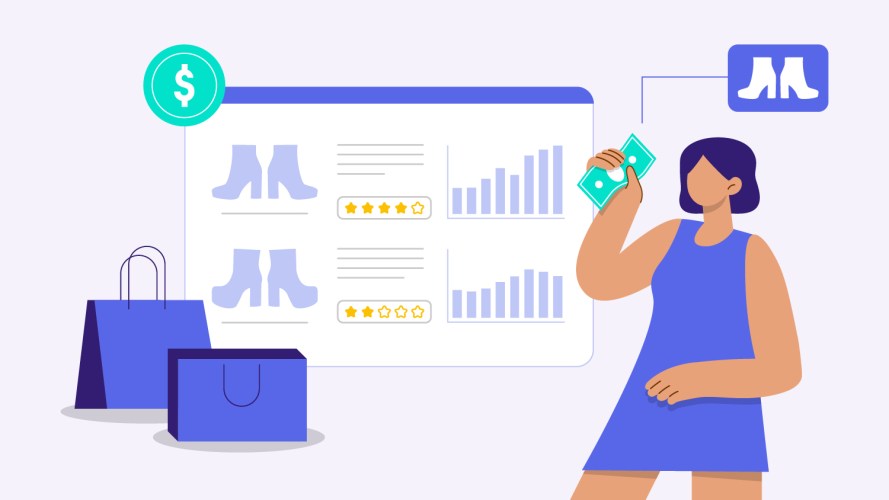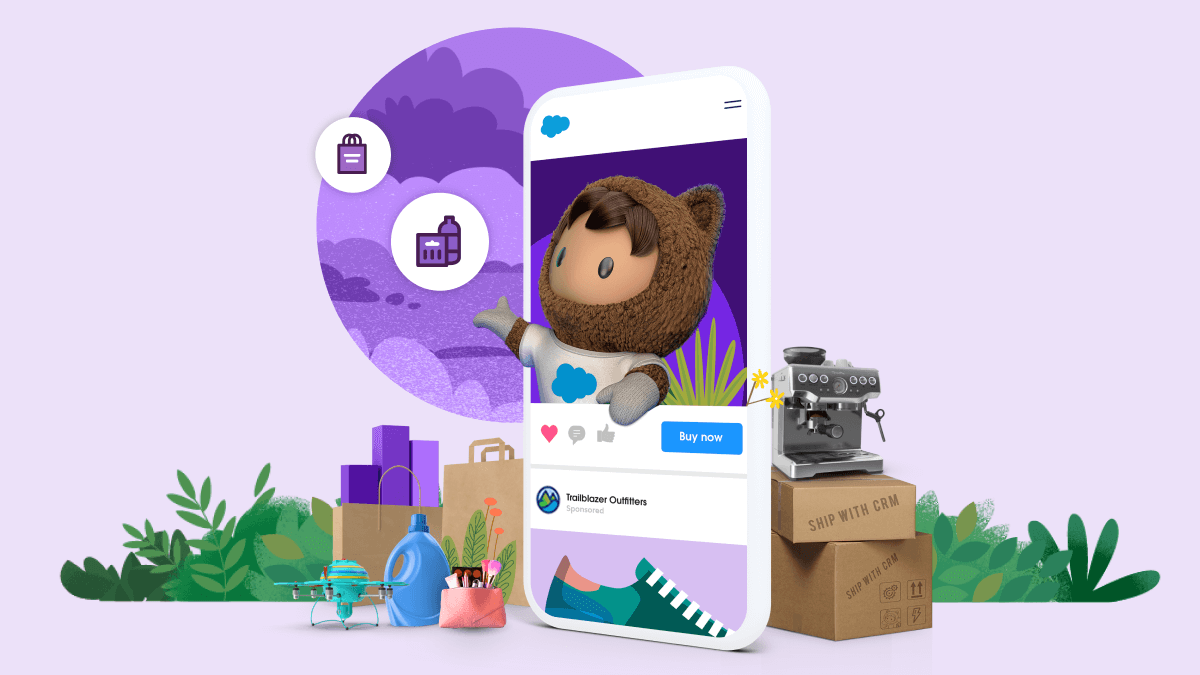Despite Challenges, Retailers Find Ways to Build Loyalty and Grow Wallet Share

Our research uncovered how CRM data, AI, and other retail trends are transforming the shopping landscape.
As current retail trends increasingly show the blurring of digital and physical shopping, retailers are connecting with shoppers in more ways than ever before. The good news is this gives retailers more chances to prove they recognize, understand, and value shoppers. The bad news? Retailers have a short window to impress shoppers before they walk away.
Not to mention they have some obstacles to overcome first: Retailers we surveyed said increased competition is their top challenge, followed by shipping costs, supply chain difficulties, and changing customer expectations. In this uncertain economy, can retailers beat slim margins and satisfy shoppers, too? Retailers believe the answer is yes, if they can humanize increasingly digital experiences.
We talked to 2,500 shoppers and 1,125 retail industry experts around the world to find out how the retail industry is changing to meet shoppers’ evolving expectations. In this blog, we’ll look at five of the retail trends we identified in The Connected Shoppers Report.
Retail trends to jump on now:
- Retail trend #1: Retailers are meeting shoppers at the edge
- Retail trend #2: Stores are becoming differentiated experiences
- Retail trend #3: Retailers dive deep into customer data for intelligent insight
- Retail trend #4: Customer service drives shopper loyalty
- Retail trend #5: Loyalty program data fuels increased engagement
Despite challenges, retailers see opportunities to build loyalty and grow share of wallet through personalization of customer service, ecommerce, and marketing. But achieving their goals requires a heavier reliance on data, insights, and technology — and the retailers that don’t keep up risk getting left behind.
Retail trend #1: Retailers are meeting shoppers at the edge
More than ever, customers find you in many different ways. While shoppers split their purchases nearly evenly between stores and online in 2023, by the end of 2025, shoppers expect they’ll complete only 44% of transactions in the store.
Where will they go instead? In addition to websites, apps, and online marketplaces, shoppers will continue to test newer digital channels like social media and voice assistants for inspiration and buying. In fact, many consumers are “shopping at the edge,” meaning they start — and increasingly complete — a buying journey outside of a retailer’s physical and digital spaces.
For starters, 50% of shoppers said they discover new products on social media. What’s more, the share of shoppers who actually buy on social media nearly quadrupled to 59% in only two years, up 15% in 2023. Completing purchases over messaging apps like WeChat and Facebook Messenger also skyrocketed: 36% of shoppers said they’d bought this way, up from 11% in 2021. It’s never been more important for retailers to offer a true omnichannel experience to shoppers.
Check out more shopping insights
As part of that omnichannel engagement, generative artificial intelligence (AI) is changing the way shoppers shop. Consumers are interested in using generative AI to help them research products, get recommendations, and find inspiration across a wide range of product categories, with 17% of holiday shopping purchases in November and December of 2023 influenced by AI.
What you can do: Use targeted, channel-specific strategies across all touchpoints where your shoppers are active. Optimize digital engagement by using data and AI to streamline and personalize the buying experience. Retailers we surveyed are using AI to create conversational digital shopping assistants to help shoppers find the right products (55%), digital models for product detail pages (52%), and personalized product bundles (51%) to boost conversion.
(Back to top.)
Retail trend #2: Stores are becoming differentiating experiences
Consumers choose in-store shopping for a number of reasons — when they want their merchandise immediately, so they can test the merchandise quality, to avoid shipping fees, or to take advantage of in-store promotions. When they do head to the store, shoppers want to experience your brand in a way that makes it stand out from other options.
Today, many retailers are exploring additional services that elevate their store experiences above the competition. Retailers said they are leaning into appointment scheduling (59%) and on-site spaces for special events (51%) to make in-store shopping memorable. From personal shopping to blowout events with exclusive products and deals, these encounters build loyalty by helping customers feel recognized, understood, and appreciated.
And while some shoppers will remain devoted online buyers, there’s no doubt they sometimes cross over between in-store and virtual experiences. Shoppers continue to use stores as fulfillment centers, with 57% purchasing a product online to pick up at the store and 53% going to the store to return a product. In fact, the number of shoppers who returned a product in a store grew by 13% since 2021. And retailers are taking note: In 2023, 64% of retailers offered in-store returns of online purchases and 58% offered buy online, pick up in-store.
What you can do: Continue to invest in retraining and upskilling your store associates, who no doubt are doing much more than stocking shelves and ringing up customers at the checkout. Today associates are handling customer service, hosting in-store events, keeping tabs on social media, and fulfilling online orders. Be sure you are providing them with both the tools and the data they need to efficiently and effectively offer standout experiences to shoppers.
(Back to top.)
Retail trend #3: Retailers dive deep into customer data for intelligent insight
Retailers told us personalization is a top priority. It’s easy to see why: Nearly three-quarters of customers expect companies to understand their unique needs and expectations. To break through the noise — where one-size-fits-all communications aren’t enough to attract attention — 93% of retailers say they are investing in personalization more than ever before. In just two years, the percentage of retailers that claim a full ability to use customer data to personalize shopper engagement has nearly doubled from 32% in 2021 to 57% in 2023.
How are they doing it? By breaking down data silos and unifying their customer data so they can gain a holistic view of shoppers. Retailers are adopting unified engagement platforms to simplify and operationalize data, build customer profiles, and create personalized and seamless experiences across touchpoints. In fact, 60% of respondents are in the strategy or execution phase of their initiatives, while another 11% are already realizing the benefits.
Some retailers still have work to do, however: 59% said marketing, ecommerce, and service functions are still managed through separate systems or applications. And integrating all this data is critical, especially for retailers who want to push forward generative AI initiatives.
Indeed, retailers see generative AI as a way to accelerate their personalization efforts. Already, 58% of retailers are using AI to jumpstart content creation for channels such as display ads, social media, and email. They also believe generative AI will help them automate the development of personalized marketing emails and promotional offers, saving time and money.
What you can do: AI is only effective if the data it’s trained on is relevant and accurate. Unlocking, harmonizing, and operationalizing your trusted data before launching generative AI initiatives is critical to driving personalized experiences and profitable engagement.
(Back to top.)
Retail trend #4: Customer service drives shopper loyalty
Great customer service can make or break your bond with shoppers. Consumers will choose one brand over another based on better service rather than product quality or pricing. But 53% of shoppers say poor customer service tops their list of worst retail experiences. So it’s not surprising that one-third of retailers have made service their top priority.
But today’s omnichannel shoppers have an expanded view of what retail customer service means. It’s so much more than returning an unused item at the dark counter at the back of a store. Shoppers consider perks like free shipping, loyalty rewards, simple returns, extensive product variety, and exclusive shopping events all part of top-notch service.
They also expect this service across all touchpoints in their buying journey, so boosting service on digital channels is just as important as training friendly store associates to cater to in-person queries. In fact, 57% of shoppers prefer to engage companies digitally. Email, chat, social media, and text are particularly popular among retailers.
Still, don’t forget about the phone. While email has eclipsed voice as the most used channel, service professionals prefer the phone when an issue is especially complex: 81% say the phone is the preferred channel when a shopper has a complicated question.
It’s worth the effort to focus on service: 94% of shoppers say good customer service makes them likely to buy again from your brand.
What you can do: Use AI to streamline and bolster customer service. Combining AI with your customer data humanizes service at every touchpoint and lets you scale high-touch service. That’s why 81% of retailers say their use of AI in service has increased, particularly for drafting personalized responses to shopper inquiries, leveling up chatbot interactions, and automating the creation of knowledge articles.
(Back to top.)
Retail trend #5: Loyalty program data fuels increased engagement
Loyalty program members are often a retailer’s most valuable customers because they frequently outspend other shoppers. But the number of loyalty programs shoppers belong to has decreased 21% in the last few years, down to 3.4 loyalty programs in 2023. Still, loyalty programs are often worth the effort for retailers: 58% of shoppers say a loyalty program makes them more likely to buy from a brand or retailer.
The data available through loyalty program engagement is a gold mine for retailers. But if you want to realize that value, your shoppers need to do more than just sign up. They need to use the program and redeem rewards. What motivates shoppers to use your loyalty program? With inflation continuing to pressure budgets, shoppers are most likely to belong to programs that offer financial savings. In 2023, the most common programs included benefits like earning points to shop, getting special discounts, and free shipping. Retailers interested in stemming the tide of loyalty program defections also may look to other models such as tiered, hybrid, or coalition programs that attract a sizable, if smaller, cohort of shoppers.
Unsurprisingly, retail decision-makers’ top goal for loyalty programs is customer retention. Yet other benefits — including increased customer engagement, repeat purchasing, and customer acquisition — are nearly as important. Already, 75% of retailers offer a loyalty program, with another 22% planning to introduce one by the end of 2025.
What you can do: To see real ROI from your loyalty program, make it easy for shoppers to sign up and, more importantly, redeem rewards. Keep track of points for them, and remind them at checkout — whether online or in the store — if they have perks they can use immediately.
(Back to the top.)
Make the most of today’s retail trends
Today’s top retail trends put the customer at the center of everything you do. As their expectations continue to evolve and change, you’ll need to pivot quickly to stay competitive.
If you’ve been collecting customer data, you’re off to a good start. But to stay ahead of the competition, you’ll need to make your data accessible across your organization at the moment the shopper is ready to buy.
To learn more about these trends and the other data points we uncovered in our research, get your free download of The Connected Shoppers Report, Fifth Edition.





























